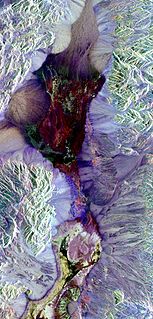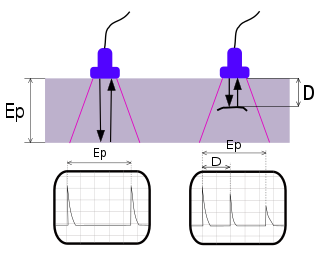Related Research Articles

A time-domain reflectometer (TDR) is an electronic instrument used to determine the characteristics of electrical lines by observing reflected waveforms.

A waveguide is a structure that guides waves, such as electromagnetic waves or sound, with minimal loss of energy by restricting the transmission of energy to one direction. Without the physical constraint of a waveguide, wave intensities decrease according to the inverse square law as they expand into three dimensional space.
In electrical engineering, partial discharge (PD) is a localized dielectric breakdown (DB) of a small portion of a solid or fluid electrical insulation (EI) system under high voltage (HV) stress. While a corona discharge (CD) is usually revealed by a relatively steady glow or brush discharge (BD) in air, partial discharges within solid insulation system are not visible.

Ellipsometry is an optical technique for investigating the dielectric properties of thin films. Ellipsometry measures the change of polarization upon reflection or transmission and compares it to a model.

Finite-difference time-domain (FDTD) or Yee's method is a numerical analysis technique used for modeling computational electrodynamics. Since it is a time-domain method, FDTD solutions can cover a wide frequency range with a single simulation run, and treat nonlinear material properties in a natural way.

Polarimetry is the measurement and interpretation of the polarization of transverse waves, most notably electromagnetic waves, such as radio or light waves. Typically polarimetry is done on electromagnetic waves that have traveled through or have been reflected, refracted or diffracted by some material in order to characterize that object.

Ultrasonic testing (UT) is a family of non-destructive testing techniques based on the propagation of ultrasonic waves in the object or material tested. In most common UT applications, very short ultrasonic pulse-waves with center frequencies ranging from 0.1-15 MHz, and occasionally up to 50 MHz, are transmitted into materials to detect internal flaws or to characterize materials. A common example is ultrasonic thickness measurement, which tests the thickness of the test object, for example, to monitor pipework corrosion.
Level sensors detect the level of liquids and other fluids and fluidized solids, including slurries, granular materials, and powders that exhibit an upper free surface. Substances that flow become essentially horizontal in their containers because of gravity whereas most bulk solids pile at an angle of repose to a peak. The substance to be measured can be inside a container or can be in its natural form. The level measurement can be either continuous or point values. Continuous level sensors measure level within a specified range and determine the exact amount of substance in a certain place, while point-level sensors only indicate whether the substance is above or below the sensing point. Generally the latter detect levels that are excessively high or low.

Neutron reflectometry is a neutron diffraction technique for measuring the structure of thin films, similar to the often complementary techniques of X-ray reflectivity and ellipsometry. The technique provides valuable information over a wide variety of scientific and technological applications including chemical aggregation, polymer and surfactant adsorption, structure of thin film magnetic systems, biological membranes, etc.
The angular spectrum method is a technique for modeling the propagation of a wave field. This technique involves expanding a complex wave field into a summation of infinite number of plane waves of the same frequency and different directions. Its mathematical origins lie in the field of Fourier optics but it has been applied extensively in the field of ultrasound. The technique can predict an acoustic pressure field distribution over a plane, based upon knowledge of the pressure field distribution at a parallel plane. Predictions in both the forward and backward propagation directions are possible.
Terahertz tomography is a class of tomography where sectional imaging is done by terahertz radiation. Terahertz radiation is electromagnetic radiation with a frequency between 0.1 and 10 THz; it falls between radio waves and light waves on the spectrum; it encompasses portions of the millimeter waves and infrared wavelengths. Because of its high frequency and short wavelength, terahertz wave has a high signal-to-noise ratio in the time domain spectrum. Tomography using terahertz radiation can image samples that are opaque in the visible and near-infrared regions of the spectrum. Terahertz wave three-dimensional (3D) imaging technology has developed rapidly since its first successful application in 1997, and a series of new 3D imaging technologies have been proposed successively.
Digital speakers or Digital Sound Reconstruction (DSR) system are a form of loudspeaker technology. Not to be confused with modern digital formats and processing, they are yet to be developed as a mature technology, having been experimented with extensively by Bell Labs as far back as the 1920s, but not realized as commercial products.
Electromagnetic acoustic transducer (EMAT) is a transducer for non-contact acoustic wave generation and reception in conducting materials. Its effect is based on electromagnetic mechanisms, which do not need direct coupling with the surface of the material. Due to this couplant-free feature, EMATs are particularly useful in harsh, i.e., hot, cold, clean, or dry environments. EMATs are suitable to generate all kinds of waves in metallic and/or magnetostrictive materials. Depending on the design and orientation of coils and magnets, shear horizontal (SH) bulk wave mode, surface wave, plate waves such as SH and Lamb waves, and all sorts of other bulk and guided-wave modes can be excited. After decades of research and development, EMAT has found its applications in many industries such as primary metal manufacturing and processing, automotive, railroad, pipeline, boiler and pressure vessel industries, in which they are typically used for nondestructive testing (NDT) of metallic structures.

Surface plasmons (SPs) are coherent delocalized electron oscillations that exist at the interface between any two materials where the real part of the dielectric function changes sign across the interface. SPs have lower energy than bulk plasmons which quantise the longitudinal electron oscillations about positive ion cores within the bulk of an electron gas.
Acoustic microscopy is microscopy that employs very high or ultra high frequency ultrasound. Acoustic microscopes operate non-destructively and penetrate most solid materials to make visible images of internal features, including defects such as cracks, delaminations and voids.

Metamaterial antennas are a class of antennas which use metamaterials to increase performance of miniaturized antenna systems. Their purpose, as with any electromagnetic antenna, is to launch energy into free space. However, this class of antenna incorporates metamaterials, which are materials engineered with novel, often microscopic, structures to produce unusual physical properties. Antenna designs incorporating metamaterials can step-up the antenna's radiated power.
Spread-spectrum time-domain reflectometry (SSTDR) is a measurement technique to identify faults, usually in electrical wires, by observing reflected spread spectrum signals. This type of time-domain reflectometry can be used in various high-noise and live environments. Additionally, SSTDR systems have the additional benefit of being able to precisely locate the position of the fault. Specifically, SSTDR is accurate to within a few centimeters for wires carrying 400 Hz aircraft signals as well as MIL-STD-1553 data bus signals. AN SSTDR system can be run on a live wire because the spread spectrum signals can be isolated from the system noise and activity.
Noise-domain reflectometry is a type of reflectometry where the reflectometer exploits existing data signals on wiring and does not have to generate any signals itself. Noise-domain reflectometry, like time-domain and spread-spectrum time domain reflectometers, is most often used in identifying the location of wire faults in electrical lines.
A capacitive micromachined ultrasonic transducer (CMUT) is a relatively new concept in the field of ultrasonic transducers. Most of the commercial ultrasonic transducers today are based on piezoelectricity. CMUTs are the transducers where the energy transduction is due to change in capacitance. CMUTs are constructed on silicon using micromachining techniques. A cavity is formed in a silicon substrate, and a thin layer suspended on the top of the cavity serves as a membrane on which a metallized layer acts an electrode, together with the silicon substrate which serves as a bottom electrode.

A TDR moisture sensor employs time-domain reflectometry (TDR) to measure moisture content indirectly based on the correlation to electric and dielectric properties of materials, such as soil, agrarian products, snow, wood or concrete.
References
- ↑ Smail, M.K.; Hacib, T.; Pichon, L.; Loete, F. (2011), "Detection and Location of Defects in Wiring Networks Using Time-Domain Reflectometry and Neural Networks", IEEE Transactions on Magnetics , 47 (5): 1502–1505, Bibcode:2011ITM....47.1502S, doi:10.1109/TMAG.2010.2089503
- ↑ Furse, C.; Haupt, R. (2001), "Down to the wire: The hidden hazard of aging aircraft wiring", IEEE Spectrum , 38 (2): 35–39, doi:10.1109/6.898797
- ↑ McClements, D.J.; Fairley, P. (1990), "Ultrasonic pulse echo reflectometer", Ultrasonics, 29 (1): 58–62, doi:10.1016/0041-624X(91)90174-7
- ↑ Soller, B.J.; Gifford, D.K.; Wolfe, M.S.; Froggatt, M.E. (2005), "High resolution optical frequency domain reflectometry for characterization of components and assemblies", Optics Express, 13 (2): 666–674, Bibcode:2005OExpr..13..666S, doi: 10.1364/OPEX.13.000666
- ↑ Furse, C.; C.C., You; Dangol, R; Nielsen, M.; Mabey, G.; Woodward \first6=R. (2003), "Frequency-Domain Reflectometery for on-Board Testing of Aging Aircraft Wiring", IEEE Trans. Electromagn. Compat. , 45 (2): 306–315, doi:10.1109/TEMC.2003.811305